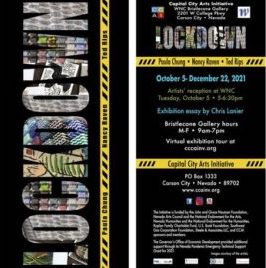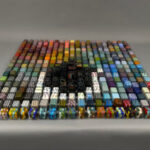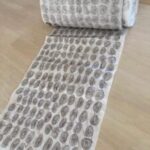Lockdown Exhibition Spotlights Creativity from COVID-19 Crisis
Lockdown Exhibition Spotlights Creativity from COVID-19 Crisis
Sep 28, 2021

‘Lockdown’ Exhibition Spotlights Creativity from COVID-19 Crisis
The Capital City Arts Initiative is presenting artwork created by three artists during the 2020 COVID-19 crisis at Western Nevada Colleges Bristlecone Main Gallery starting Oct. 5.
Lockdown, which includes art by Paula Chung, Nancy Raven and Ted Rips, will be shown through Dec. 22 on WNCs Carson City campus, 2201 W College Parkway.

Ted Rips 400-plus glass cubes were born from his days of lockdown isolation.
A reception for the Lockdown artists, as well as artists from three prior exhibitions, is scheduled for 5 to 6:30 p.m. on Tuesday, Oct. 5 in the Bristlecone Gallery.
Each of the Lockdown artists began their project either as a way to memorialize the ongoing COVID deaths, to protect themselves from the lockdowns isolation or just as a way to keep busy or all three.
When the COVID-19 pandemic began and then grew worse, Chung felt personally compelled to respond in some way, to memorialize the people who had lost their lives to the virus. She chose a spiral as a symbol of life for her work titledRequiem.
Using rolls of Japanese rice paper, called Dragon Cloud, as a foundation for her machine embroidery, she began stitching one oval for each life lost. She used two different colors of thread through the needle of her sewing machine to increase the depth of the thread color, currently, using blue and orange. Each paper scroll is 60 feet by 11 inches and holds an estimated 8,684 spirals. Chung tracked her progress on a calendar and to date has made about 338,000 spirals on 40 scrolls extending more than a third of a mile. With her husband and pet cats, Chung divided her time between the Nevada side of Lake Tahoe and Southern California.

Paula Chung tracks her progress on a calendar and to-date has made about 338,000 spirals on 40 scrolls extending to more than a third of a mile.
Raven, a nonagenarian and Carson City resident reacted to the COVID lockdown with a burst of energy and began carving printmaking blocks. In the early 1950s, her then fianc and eventual husband was in Japan and sent her a letter every day that included a small drawing on the outsides of the envelopes.
In 2020, she used 12 of his drawings as a point of reference and revisited decades of her own notebooks to make the six-dozen small prints. Using linoleum blocks and printing on black paper, Raven created several series based on kids, geishas, landscapes and Japan. After printing them, she then hand-colored each image.
I had his letters and all these sketch books from the years when my children were little and doing these prints was a good way to pass the time during the lockdown, she said. I worked with the images that I loved.
Rips 400-plus glass cubes were born from the days of lockdown isolation and he counted those days in brilliant color. He also built some mostly black cubes to represent COVID itself and some white ones representing antibodies.
As our nation began slipping into an unimaginable tragedy, this project began as way for me to regain some sanity, Rips said. Locked down under our Southern California stay-at-home order, I decided to get off the couch, walk away from the TV and try to get creative in my studio. This gave me the chance to express myself in a way I never imagined. Confined to a 2-inch by 2-inch x 1 -inch format and using glass as my medium, I createdCOVID Cubesto mark time in isolation, create a unique color study, and to memorialize this once-in-a-lifetime event.
When the story is finally told, I think someone will write about the fact that many people actually found themselves in 2020. People learned to write, create poems, make music, adapt in ways we never thought we could. Some artists like myself, who doubted our talent, found it.
Chris Lanier, a professor of digital art at Sierra Nevada University, wrote the exhibition essay forLockdown.
Carlos Ramirez, a Western Nevada College Latino Leadership Academy student, provided a Spanish language translation of the shows wall text.